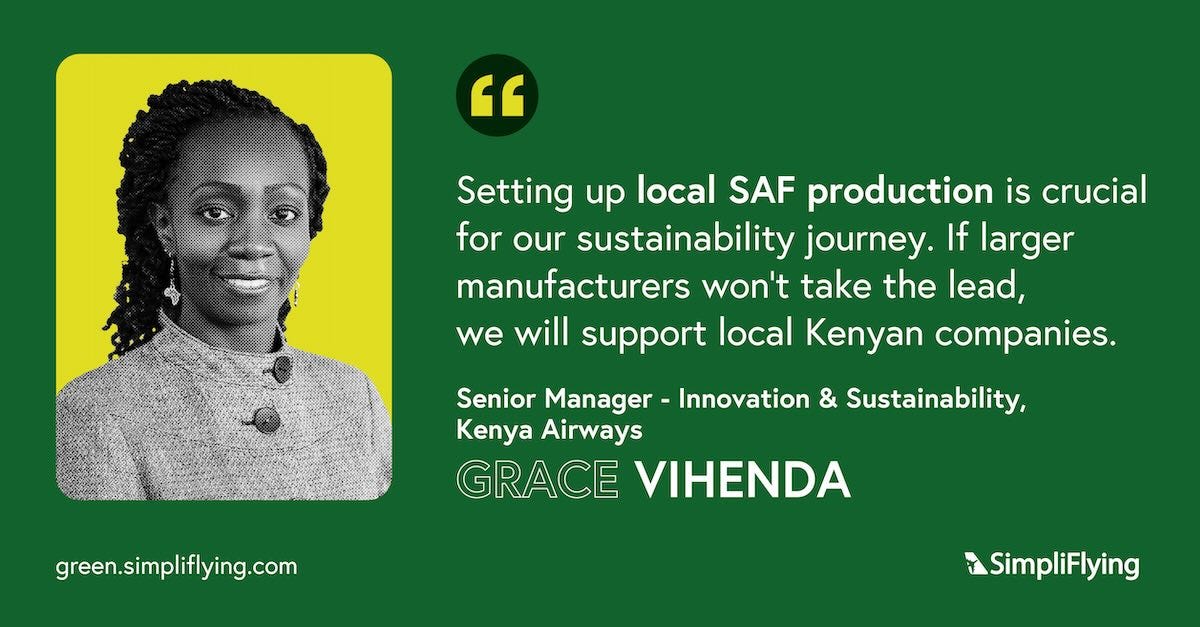In this episode of our ‘Sustainability in the Air’ podcast, Grace Vihenda, Senior Manager of Innovation and Sustainability at Kenya Airways speaks with SimpliFlying’s CEO Shashank Nigam, and shares the airline’s efforts to promote sustainable aviation in Africa, a continent with abundant resources for sustainable aviation fuel (SAF) production but limited infrastructure and investment.
Vihenda also discusses the unique challenges and opportunities faced by the African aviation industry, and the potential for Kenya to emerge as a significant contributor to the production of SAF on a global scale.
Here are the key highlights of the conversation:
Kenya’s abundant resources for SAF production (2:05)
Kenya Airways’ ground-breaking SAF flight and challenges (3:30)
Growing sustainability awareness among customers in Kenya (8:40)
The need for increased flying in Africa and sustainable growth (9:52)
Kenya Airways’ operational sustainability initiatives (16:20)
Navigating the financial challenges of the green transition (25:57)
Rapid Fire! (37:51)
Keep reading for a quick overview of the episode.
Why Kenya Airways’ groundbreaking SAF flight matters
In 2023, Kenya Airways became the first African airline to use a 2% SAF blend for an intercontinental long-haul flight. The flight was conducted as a part of SkyTeam’s The Sustainable Flight Challenge. Notably, the flight was conducted despite multiple challenges: the lack of a SAF policy framework in the country; the need to purchase the fuel from overseas at a significantly higher cost; and the lack of local infrastructure.
In the absence of a regulatory guideline or framework, Kenya Airways had to develop everything from scratch. The airline took on the role of advising government agencies on the processes involved in a SAF-powered flight, and even assisted in setting up tests for jet fuel and SAF blends, in accordance with international standards.
Due to the lack of local SAF production facilities, Kenya Airways had to purchase the fuel from a producer in Italy. The SAF, made from Kenyan feedstocks which were shipped overseas for processing, was bought back by the airline at “about seven times the price of jet fuel,” says Vihenda. This added significantly to the cost and complexity of the operation.
Once the SAF arrived in Kenya, the airline encountered another hurdle: the absence of local blending capabilities. To overcome this, the airline collaborated with a local supplier to build the necessary infrastructure and expertise to blend the SAF with conventional jet fuel and safely fuel the aircraft.
The SAF flight has been instrumental in helping chart the course for supportive policy action and signal the need to set up local SAF production. Kenya Airways is currently in the process of conducting trials, testing, and certifying locally produced SAF, with the aim of eventually scaling up production for commercial use.
4 takeaways from the conversation
1. The case for increased flying in Africa
While environmental activists, particularly in Europe, advocate for “flying less” to reduce emissions, Vihenda argues that Africa’s unique challenges and developmental needs necessitate a different approach. As the second largest continent, Africa has an expansive area that is riddled with poor connectivity and underdeveloped infrastructure.
As African countries continue to develop, the demand for air travel will naturally increase to connect the continent from west to east and north to south, says Vihenda. Instead of focusing on flying less, the priority for Africa should be on flying more sustainably, she adds.
“We’re still developing. We still have a lot of connectivity issues and inadequate infrastructure when it comes to transport. So air travel becomes the most ready form of moving about. So definitely, we will fly more. It’s more a question of how do we do this a lot more sustainably.”
2. Kenya’s untapped potential for SAF production
Kenya’s ideal weather conditions and extensive land resources make the country well-suited for energy-producing crops. Crops like Castor and Jatropha, which can be used as bio-feedstocks for SAF production, thrive in Kenya’s climate, says Vihenda. Moreover, with 90% of the country’s electricity grid already powered by renewable energy, and an abundance of sunshine and wind power, Kenya is well-positioned to support the production of both bio-SAF and e-SAF, she adds.
However, the local production of SAF still remains quite under-developed. Vihenda stresses that for Kenya Airways to be truly sustainable in its SAF journey, local production is essential. She argues that if larger, international manufacturers are unwilling to set up SAF production facilities in Kenya, the country must develop its own capabilities. By supporting local manufacturers and entrepreneurs, Kenya Airways aims to contribute to the sustainable development of Africa’s aviation industry and the broader economy.
3. Exploring the use of green hydrogen for SAF
While green hydrogen is already used in Kenya for the production of fertilisers, its application in aviation is still in its very nascent stages. Vihenda acknowledges that there is significant potential for green hydrogen to contribute to the decarbonisation of aviation, both as a direct fuel source for aircraft and as a feedstock for the production of e-fuels.
“We are definitely considering green hydrogen for e-fuels, and are in talks with two companies that are still in very early stage when it comes to e-SAF. It is definitely in our plan to explore that further, to see how we can use this technology for e-SAF.”
4. Navigating the financial challenges of the green transition
Vihenda identifies budgets and finances as the most significant hurdles Kenya Airlines faces in its sustainability journey. She notes that funding the green transition will be quite expensive, and even though it may lead to cost savings in the long run, the large upfront capital investment required poses significant challenges.
Vihenda suggests that the cost associated with the airline’s sustainability transition cannot be passed onto the customers, as they are generally unwilling to bear those additional costs. Instead, Kenya Airways is focusing on setting up internal funding for initiatives that have clear cost-saving potential. For example, the installation of solar panels across the airline’s offices, which requires significant upfront capital, is expected to result in long-term savings. To support its SAF uptake, however, Kenya Airways plans to introduce a voluntary SAF program for customers who wish to contribute by paying a small premium.
Vihenda emphasises the importance of collaboration and partnerships in advancing sustainability in the aviation industry. By working closely with government agencies, industry partners, and financial institutions, Kenya Airways hopes to secure the necessary funding to drive its sustainability agenda.
‘Sustainability in the Air’ is the world’s leading podcast dedicated to sustainable aviation. Through in-depth conversations with top aviation leaders, we break through the clutter and provide a clear roadmap for a net-zero future.














